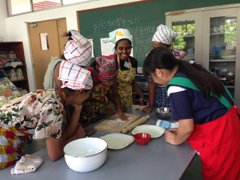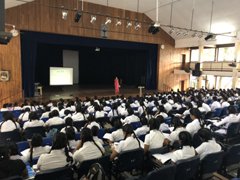Expansion of Learning
University of Kelaniya
KOMATSUBARA Naho
1. Activities at the University of Kelaniya
Sri Lankan top-level students are currently studying the Japanese language and culture at the University of Kelaniya where I work. In this report, I will introduce the activities of the Japanese-Language Club, run primarily by the students, and the Research Center for Japanese Studies (hereinafter “RCJS”) run primarily by teachers.
Activities of the Japanese-Language Club

Japanese junior high school students teach how to make udon.
Students in the Japanese Course run their own Japanese-Language Club to learn and communicate about the Japanese culture and language.
The Japanese-Language Club is in charge of the afternoon cultural portion of the O-level seminar held each year by University of Kelaniya for Sri Lankan junior secondary students. A demonstration of making Tempura Udon was given for the roughly 600 students who participated in the seminar this year. The Club members learned the skill from the Japanese junior high school students at the Japanese School in Colombo when they visited for a conversation class. The secret ingredient in the udon is surely the desire that Club members had to share the delicious taste and fun experience with their juniors. The Tempura Udon was apparently “delicious” according to the junior secondary students who ate it for the first time, as Sri Lanka does not have a tradition of eating noodle soups.
The club also began a program this academic year for the donation of recorders and pianicas, given by Japanese elementary and junior high school students, to Sri Lankan schools in cooperation with the Association of International Music Exchange for Children (AIMEC). The first donation ceremony, held at Hiswela Primary School, was met with a big welcome of song and dance by the children, and club members taught the children about Japanese culture including Japanese songs and Origami. While second-hand, the pianicas that arrive from Japan are imbued with a warmth not present in new ones. Each instrument is carefully cleaned by the AIMEC members, and the name of the Japanese students who used them are left visible. Surely the Sri Lankan children understood this message of taking care of things that is part of Japanese culture.
By sharing the learning they received in the University or from Japan with others in Sri Lanka, the Club members are likely growing as well.
Activities of RCJS
Students are not the only ones who are active at the University of Kelaniya. The teachers are also going beyond their university to support Japanese-language education throughout Sri Lanka. The members of RCJS are proactively establishing textbooks and books as a reference for junior secondary schools in Sri Lanka, and holding seminars on the use thereof. Last academic year, the RCJS published a textbook on intercultural understanding for junior secondary students entitled Intercultural Communication Part I, and a literature text for senior secondary students entitled the Japanese Literature Resource Book and hold a seminar. The seminar brought together teachers from Sri Lankan junior secondary schools who eagerly studied the concepts and use of the books in order to take them home and use in their daily classes. The group has future plans to create textbooks on Kanji, listening, and conversation, and to hold seminars to go along with publication so that the textbooks may be utilized effectively.
In addition to the support for secondary education by RCJS, the university is also working to develop itself as well, such as working to establish a new Post Graduate Diploma Course this year. They carry on their activities diligently in the hopes to one day branch out as a separate Japanese Department or to even establish a graduate school.
Accordingly, the University of Kelaniya is contributing to Japanese-language education in Sri Lanka in a variety of ways, including by increasing the number of Japanese language learners through the enrichment of secondary education as a gateway to Japanese learning, comprising the majority of current learners, and by establishing a graduate school for higher education to which those learners are ultimately headed in order to enhance the educational quality.
2. Activities of the Japanese Teachers Association of Sri Lanka
Sri Lanka has the Japanese Teachers’ Association of Sri Lanka (hereinafter the “Association”) for Japanese teachers in the country to gather and learn from each other. The Japanese-Language Specialists support teachers throughout Sri Lanka through the Association. In addition to a regular bi-monthly meeting, the association also hosts seminars of Japanese-language education for teachers and A-Level seminars for senior secondary school students.
One such A-Level seminar was held in Colombo in March 2018, with attendance from roughly 600 senior secondary students from throughout the country. The students studied quite diligently in the hot school building from 8:00 AM until 5:00 PM.
In this way, the educational information shared by the University of Kelaniya and the Association is spreading throughout Sri Lanka.

Senior secondary school students studying diligently.
*Association of International Music Exchange for Children (AIMEC): http://aimec-jp.org/
- What We Do Top
- Arts and Cultural Exchange [Culture]
- Japanese-Language Education Overseas [Language]
- Japanese-Language Education Overseas [Language] Top
- Learn Japanese-language
- Teach Japanese-language
- Take Japanese-Language Test
- Know about Japanese-language education abroad
- The Japanese-Language Institute, Urawa
- The Japanese-Language Institute, Kansai
- Japanese-Language Programs for Foreign Specified Skilled Worker Candidates
- Japanese Language Education for Japanese Children Resident Overseas and for the Descendants of Migrants
- Archives
- Japanese Studies and Global Partnerships [Dialogue]
- JF digital collection
- Other Programs / Programs to Commemorate Exchange Year
- Awards and Prizes
- Publications
